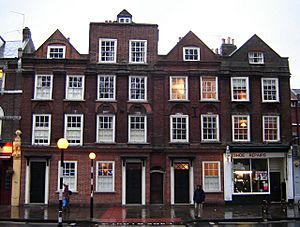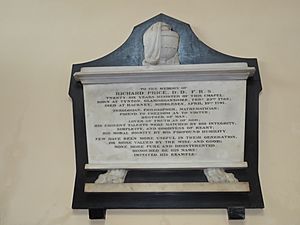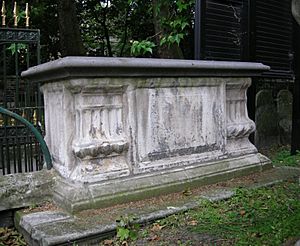Richard Price facts for kids
Quick facts for kids
Richard Price
|
|
|---|---|
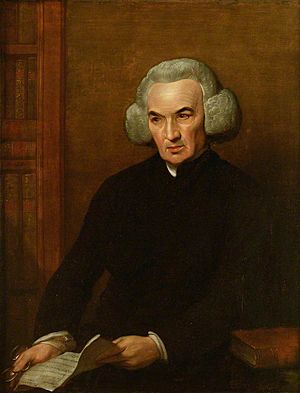
Portrait of Dr Richard Price (1784), by Benjamin West
|
|
| Born | 23 February 1723 Tynton, Llangeinor, Glamorgan
|
| Died | 19 April 1791 (aged 68) Newington Green, London
|
| Known for | Bayes–Price theorem |
| Signature | |
Richard Price (born February 23, 1723 – died April 19, 1791) was an important British thinker. He was a moral philosopher, which means he thought deeply about right and wrong. He was also a Nonconformist minister, a type of Protestant church leader. Besides this, he was a talented mathematician.
Price was also a political reformer. He actively supported big changes like the American Revolution and the French Revolution. He knew many famous people, including Thomas Jefferson and George Washington. Many historians believe he was one of the greatest Welsh thinkers ever.
Born in Llangeinor, Wales, Price spent most of his life near London. He worked as a minister at Newington Green Unitarian Church. He helped develop important ideas in mathematics and how to understand population data. He was also a member of the Royal Society, a group for top scientists.
Contents
Richard Price's Early Life
Richard Price was born on February 23, 1723, in a farmhouse called Tyn Ton. This was in the village of Llangeinor, Wales. His father, Rhys Price, was also a Dissenting minister. Dissenters were Protestants who did not follow the main Church of England.
Richard was taught at home and then at schools in Neath and Pen-twyn. He later studied with a teacher named Vavasor Griffiths. After this, he moved to London, where he lived for the rest of his life.
In London, he continued his studies at a special school for Dissenters. After finishing school in 1744, Price became a chaplain (a minister who serves a private household or institution). He worked for George Streatfield in Stoke Newington. He also gave lectures at the Old Jewry Meeting-house. In 1757, Price married Sarah Blundell.
Life at Newington Green
In 1758, Richard Price moved to Newington Green. He lived in a very old brick house, built over a hundred years before. He became the minister for the Newington Green meeting-house. This church is still active today. Many important people were part of his church, including the family of Samuel Vaughan.
Price was very busy. In 1770, he also started preaching at another church in Hackney. But he continued his afternoon sermons at Newington Green. He also kept his duties at the Old Jewry meeting house.
Friends and Important People
Richard Price was connected to many influential people. He often met with other thinkers and leaders of his time.
Neighbors at Newington Green
One of Price's close friends was Thomas Rogers. Rogers was a banker who lived near Price. They often rode horses together to Wales. Another friend was Reverend James Burgh. Burgh ran a school and sent his students to listen to Price's sermons. Price, Rogers, and Burgh had a special dining club. They would eat at each other's homes.
The Bowood Circle
Price was part of a group of thinkers called the "Bowood circle." This group met around Lord Shelburne, a powerful politician. Price met Shelburne around 1767. He also helped Joseph Priestley, another famous scientist, get a job with Shelburne as a librarian.
"Club of Honest Whigs"
Price was also a member of an informal dining group called the "Club of Honest Whigs." This group included Benjamin Franklin, a key figure in American history. They met to discuss important ideas of the day. Other members included Sir John Pringle and Joseph Priestley.
Famous Visitors
Many famous people visited Richard Price at his home or church. These included:
- Benjamin Franklin, a Founding Father of the United States.
- Thomas Jefferson, who later became the third president of the United States.
- Thomas Paine, a writer who supported revolutions.
- John Adams, who became the second US president, and his wife Abigail Adams.
- British politicians like William Pitt the Elder.
- Philosophers such as David Hume and Adam Smith.
- The prison reformer John Howard.
Discussions with Theologians
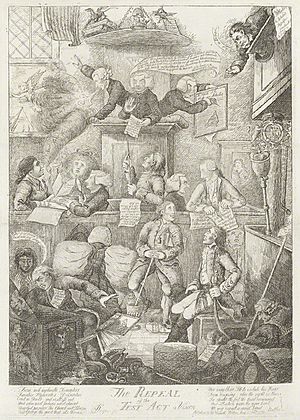
Other religious thinkers looked up to Price. These included William Ellery Channing and Theophilus Lindsey. Price helped Lindsey find a place to start a new Unitarian church in London. Price and Lindsey also worked together to promote knowledge of the Bible.
Price and Joseph Priestley had different ideas about some religious and philosophical topics. They even published letters discussing their different views. Price believed in human free will and the soul, while Priestley had different ideas.
Mary Wollstonecraft

Mary Wollstonecraft was a famous writer and early supporter of women's rights. She moved her girls' school to Newington Green in 1784. She attended Price's church services. She found the Dissenters, like Price, to be kind and respectful towards women.
Price is thought to have helped Wollstonecraft with money. Through Price, she met a publisher named Joseph Johnson. The ideas she heard from Price's sermons helped her think more about politics. She later wrote A Vindication of the Rights of Men (1790). This book was a response to Edmund Burke's criticism of the French Revolution and Price. She also wrote A Vindication of the Rights of Woman (1792). In this book, she used Price's ideas about equality to argue for women's rights.
Supporting the American Revolution
Richard Price became very famous for supporting the American colonies. He backed them in their fight for independence from Britain. In early 1776, he published a pamphlet called Observations on the Nature of Civil Liberty. This booklet sold 60,000 copies in just a few days! It attacked a British law called the Declaratory Act.
Price quickly became one of the most well-known men in England. He was even given the "freedom of the city" of London. Some say his pamphlet helped convince the Americans to declare their independence. He wrote another pamphlet in 1777. Price always spoke out against war and the problems caused by government debt.
Price's name became linked to American independence. Benjamin Franklin was a close friend. In 1778, the Continental Congress (the government of the American colonies) invited Price to America. They wanted him to help manage their money, but he turned down the offer. In 1781, Yale College gave him an honorary degree. He received this honor alongside George Washington!
When Lord Shelburne became Prime Minister in 1782, he offered Price a job as his private secretary. Price also wrote a book called Observations on the importance of the American Revolution (1784). Americans liked this book. It suggested that the biggest problem for the new American government was its lack of central power.
Later Life and Legacy
In 1767 and 1769, Price received honorary degrees from Scottish universities. Sadly, his wife Sarah died in 1786. They did not have any children.
In the same year, Price helped start Hackney New College. Richard Price died on April 19, 1791. He was buried at Bunhill Fields, a famous burial ground. Joseph Priestley gave the speech at his funeral.
Price's family included William Morgan, who became a famous actuary (someone who calculates risks and probabilities).
Remembering Richard Price

In 2022, artwork honoring Price was put up at Cardiff University. This was to celebrate the 300th anniversary of his birth.
In February 2023, a blue plaque was placed on the wall of 54 Newington Green. This plaque honors Price and marks the house where he lived. It is also near the church where he was a pastor. Many events were held in 2023 to celebrate Price's 300th birthday. These events took place in his birthplace of Llangeinor, across Wales, and in London.
See also
- Liberalism
- Contributions to liberal theory


